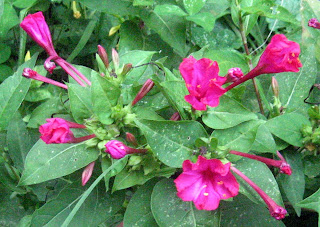Hummingbird images via
TheEye. Please visit her shop for gorgeous photography and artwork!
Everyone loves hummingbirds and many look forward to their return each year. They are tiny, gorgeous and bold. Many people set out plastic feeders with sugar water, sometimes multiple feeders because hummingbirds can be quite territorial. Hummingbirds eat spiders as well, and they make their nests out of cobwebs. So, if you wnnt to attract hummingbirds, it's yet another reason to not use pesticides.
Hummingbirds are attracted to bright colors, such as red and blue. They like tubular shaped flowers and need a wide variety to nectar to support their metabolisms. They need water too, of course, so if you are able to set up a mister that's perfect for these tiny little jewels.
If you want to plant flowers for hummingbirds, here are some suggestions.
Wild Columbine - this one comes into bloom right around the time that hummingbirds return here in zone 7. It is a gorgeous flower that likes partial shade and has drooping tubular red flowers. It will modestly self seed if allowed, or you can cut off spent flowers to produce more.
Geraniums - This is the species geranium, that often have scented foliage. There are a wide variety of these. Mine produce pink flowers that my hummingbirds hit up throughout the day.
Bee Balm - There are several species of bee balm, all of which are attractive to hummingbirds. I grow the wild bee balm that has hot pink or red flowers, and which also attracts bees and butterflies. This bee balm is also known as Oswego tea and was used widely after the Boston tea party as a tea substitute.
Zinnia - I grow lilliput zinnia and Red Spider zinnias, both heirloom varieites that hummingbirds like. They seem to prefer the lilliput zinnia, I'm guessing because of its form versus the splayed form of the Red spider zinnias.
Cypress Vine - This is a hardy and beautiful vine that is a self seeding annual. It has fern like foliage and bright red tubular flowers that begin blooming in late Summer and into the Fall. I grow this by my front porch, where it grows into a hydrangea, and I often sit on the porch and watch my little visitors zoom in for a snack.
Trumpet Vine - This one gets large, and takes a while to start blooming, but it's a good one to have. Give it a tree to climb as it will need the support. It has bright red and orange tubular flowers that a hummingbird can get lost in. :)
Wild purple petunia - This one is good for container gardening, as it does not get very big. It is an annual that produces masses of hot pink and purple tubular flowers. This is the variety that modern hybrids were descended from and is not fussy.
Jasmine tobacco - I also grow this one in containers, as it is not hardy here. It can be grown as an annual, or you can bring it in over the winter as long as you don't have critters that will try to eat it. It opens in the evening to emit an intoxicating fragrance. I was pulling off dead blossoms one night and a hummingbird flew up and hovered in front of me. I froze, as we looked at each other, inches apart, and then he zoomed off. :) It was amazing!
Four o-clocks - These perennial plants form a tuber that will grow larger each year. If you live outside their zone, the tubers may be dug up each fall. They produce hot pink and yellow flowers that open in the afternoon.
Old Fashioned Weigelia - This bush gets loads of bright red tubular flowers. It's hardy and lovely. There are many new varieties but they don't have the same attractionto hummers.
Scarlet Runner Bean - This heirloom bean is difficult to find. It gets very large beans that are supposed to be quite tasty, but many people grow it for the bright red flowers. I grew some last year, but not enough to sell. I hope to grow more this year so I'll have them for sale in Fall. :)
Blue sage - This plant is just gorgeous. It can be used like cooking sage, and has medicinal properties as well. It gets bright blue spikes of tubular blue flowers that bees and butterflies enjoy as well. It will modestly self sow once established.
Cardinal Flower - this plant gets spikes of crimson red flowers that hummingbirds love, but it needs damp soil to grow. It is most often found in the wild around ponds. I am growing some on the shaded side of my house where it stays damp from the sump pump. I just planted it last year so I'm eager to see how it does.
Red sage - This is another one with bright red flowers hummers love. I had some volunteer itself into my gardens and the hummingbirds made it a regular stop.
Cosmos - This one does not have the normal tubular flowers, but I've seen hummingbirds at it. I also see lots of birds eating the seeds, especially goldfinches, but I'll do another post on that. :)
There are many other flowers you can plant for hummingbirds, depending on your region. The ones I've listed do well in the largest part of the US and I hope give you a place to start. As birds lose their habitat, all birds, not just hummingbirds, depend more and more on backyard gardens for sustenance, especially during migration. So don't use pesticides, plant flowers, and provide water and shelter to help out our wildlife. Please check out my plant shops for many of the seeds I've mentioned here and thanks for reading!
Julie
Four O'Clocks

Cardinal Flower

Wild Columbine

Wild Purple Petunia

Cosmos

Scarlet Runner Bean

Bee Balm

Lilliput Zinnia

Weigelia

Blue Sage

Trumpet Vine

Cypress Vine



























